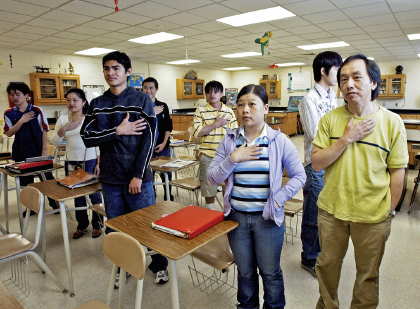Understanding World Societies:
Printed Page 1038
INDIVIDUALS IN SOCIETY
Sieng, a Mnong Refugee in an American High School

In 2008, at a large urban high school in the U.S. South, Sieng, a seventeen-
The Mnong are among a diverse group of ethnic minorities, known broadly as Montagnards, whose communities stretch across the central highlands of Vietnam. They are also a religious minority in Vietnam — many had converted to Christianity. During the Vietnam War, many Mnong provided military service alongside the United States, particularly with the U.S. Army Special Forces. After the war ended in 1975, the Mnong faced persecution and over time many fled the country, joining the current of refugees who resettled in camps in Thailand, Malaysia, the Philippines, and later Cambodia. Sieng’s family left Vietnam when he was a child in the late 1990s. He recalled his journey:
We had a hard time in Vietnam, so we had to leave. We didn’t have no choice because we had no food, and no land. And [the Vietnamese government] wanted my dad and took my grandpa. So we left in the night and went through the jungle. We walked and walked and got lost. So me and my dad tried to find the way and we found a house. Some people let us sleep there and also gave us food. Then we got to a [refugee] camp in Cambodia and stayed there for a year. I didn’t have school in Vietnam, and I didn’t have school at the camp. Then we came here.
Arriving in the United States at the age of sixteen, Sieng was not literate in Mnong, Vietnamese, or English, the language of his new school. Sieng aspired to become a Marine so he could help other refugees and his family. He explained, “A man needs to take care of the family too, and that’s what I want to do. The Marines will help me take care of my family.”
For Sieng, being a refugee instilled a sense of pride, a sense of what he and his family had overcome in coming to the United States, and a sense of what he desired for the future. As the oldest male child, Sieng was, in his words, “second in command” in the home while his father worked the third shift at a shipping facility. In the United States Sieng was an ethnic minority and a refugee with limited English skills. He was misunderstood. A classmate in a world history class asked him where he was from in Mexico, and the question made him indignant:
I am a refugee, not an immigrant! I am Mnong, not Vietnamese! But people call me Spanish. Some kids once asked me to say something in Spanish. . . And Mexican students think I’m Chinese. They say, “Hey Chino! Hey Chino!” I get mad when they do this because I am more like American. My grandpa worked with Americans [in the war].
In a diverse school, amid other immigrants and ethnic minorities, Sieng found comfort in his identity as a refugee, reflecting on his family’s past, its connection to the United States, and his role facilitating its journey, as he confronted a new environment, struggling to be understood.
Source: Liv T. Dávila, “Performing Allegiance: An Adolescent Refugee’s Construction of Patriotism in JROTC,” Educational Studies 39.5 (2014), in press. Reprinted by permission of Taylor & Francis LLC (http://www.tandfonline.com).
QUESTIONS FOR ANALYSIS
- What aspects of Sieng’s experience reflect broader patterns of migration?
- How does Sieng’s experience as a refugee shape his identity?
- What role does JROTC play in Sieng’s sense of belonging?

DOCUMENT PROJECT
What are the key issues surrounding immigration reform? Examine documents related to the debate over U.S. immigration reform, and then complete a quiz and writing assignment based on the evidence and details from this chapter. See Document Project for Chapter 33